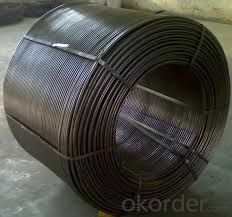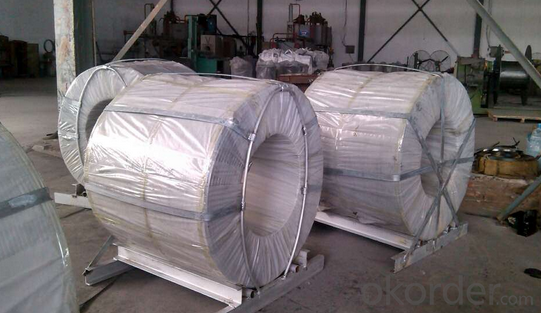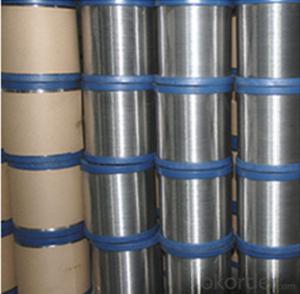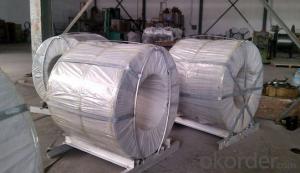CNBM Carbon Cored Wire For Feeding Machine
- Loading Port:
- Shanghai
- Payment Terms:
- TT OR LC
- Min Order Qty:
- 20 m.t.
- Supply Capability:
- 1000 m.t./month
OKorder Service Pledge
OKorder Financial Service
You Might Also Like
Quick Details
| Place of Origin: | China | Brand Name: | CNBM | Model Number: | Cr |
| Type: | Bare | Application: | Heating | Conductor Material: | Cr |
| Conductor Type: | Solid |
Packaging & Delivery
| Packaging Details: | Coil on the pallet+steel cage+damp proof film |
| Delivery Detail: | the shipment time is about 10 days from the firm order or as request |
Specifications
1.Good resistant (life) to oxidation at high temp.
2.For high value electrical resistor
3.Al heating strip
Our advantage:
We can provide high quality material, excellent design, precise manufacturing,complete specifications, considerate and integrity serivices.
We can provide all kinds of electric heating alloy material and elements, including customized products.
We can provide a complete solution for you.


Characteristics:
1.It is used by injection way.Facilitate the operation and reduce the operation cost.
2.Being propitious to adjust and control the active metal and the content of microelement.
3.Keep stable of the alloy performance function, reducing steelmaking cost.
4.Changing the inclusion form to improve the mechanical property.
Usage:
Resistance heating elements;Material in metallurgy;Household appliances;Mechanical manufacturing and other industries.
CNBM CARBON CORED-WIRE
Material SPECIFICANTION MATERIAL
C | 98%MIN |
S | 1 %MAX
|
ASHES | 1.8 % MAX,
|
VOLATILE | 1.6%Max
|
N2 | 1%Max |
WIRE DIAMETER | 13.5MM +/- 0.5MM
|
SHEATH | 0.38MM +/- 0.05MM
|
POWDER WEIGHT | 150 G/M +/-10 G/M
|
COIL INTERNAL DIAMETER | 570MM +/-10% |
COIL HEIGHT/WIDTH | 1090MM +/-10%
|
COIL EXTERNAL DIAMETER | 1100MM+/-10% |
NET WIRE WEIGHT PER COIL | 1500KG+/-10% OR AS CUSTOMER REQUEST |
Visit our wedsite: www.okorder.com or email to us for more information.
- Q:How is carbon used in the medical field?
- Carbon is used in the medical field in various ways. It is commonly used in medical imaging techniques such as positron emission tomography (PET) scans, where radioactive carbon isotopes are used to track the movement and metabolism of substances within the body. Carbon is also utilized in the production of medical implants and devices, including artificial heart valves, pacemakers, and prosthetics. Additionally, carbon-based materials are being researched for drug delivery systems, tissue engineering, and as components of medical sensors and electrodes.
- Q:What are carbon nanomaterials?
- Carbon nanomaterials are a class of materials that are composed of carbon atoms arranged in various structures at the nanoscale. These structures can include carbon nanotubes, fullerenes, and graphene. Carbon nanotubes are cylindrical structures made up of rolled-up sheets of graphene, while fullerenes are closed-cage molecules consisting of carbon atoms. Graphene, on the other hand, is a single layer of carbon atoms arranged in a hexagonal lattice. Carbon nanomaterials possess unique properties that make them highly desirable for a wide range of applications. They exhibit exceptional mechanical strength, high electrical and thermal conductivity, as well as excellent chemical stability. These properties arise from the strong covalent bonds between carbon atoms and the unique arrangements of these atoms in the nanoscale structures. Due to their remarkable characteristics, carbon nanomaterials have found numerous applications in various fields. They are used in electronics and computing devices, where their high electrical conductivity and small size make them ideal for creating faster, smaller, and more efficient components. Carbon nanotubes have also been utilized in composite materials to enhance their mechanical strength and durability. Furthermore, carbon nanomaterials have shown promise in the field of medicine and healthcare. They can be used for drug delivery systems, where they can encapsulate and transport drugs to specific targets in the body. Carbon nanomaterials have also been investigated for their antibacterial properties, making them potential candidates for developing antimicrobial coatings and surfaces. Overall, carbon nanomaterials are a diverse class of materials with exceptional properties that have led to numerous exciting applications in various industries. As research continues, their potential uses are likely to expand, revolutionizing fields such as electronics, medicine, and materials science.
- Q:I saw a cell phone in the magazine, the global release of 900, no camera, what function is F1 carbon fiber material, actually sold 40000 yuan a piece!.. Everyone said that the circulation is so small, worth so much money? Or carbon fiber material worth so much money?
- See where, in a car for example transformation kit, with super run even if the civil area shape roughly the same but the price difference, if you feel that things are expensive, natural carbon prices go up, in fact carbon species layout production process characteristics of professional strength lot, do not understand
- Q:How does carbon impact the energy balance of the Earth?
- The energy balance of the Earth is primarily influenced by carbon, which plays a significant role in the greenhouse effect. Carbon dioxide, a greenhouse gas, is emitted into the atmosphere through both natural processes and human activities such as the burning of fossil fuels and deforestation. The greenhouse effect occurs naturally when specific gases in the atmosphere trap heat from the sun, preventing it from escaping back into space. This process is essential for maintaining a suitable temperature for life on Earth. However, excessive carbon emissions have intensified the greenhouse effect, resulting in global warming and climate change. When carbon dioxide and other greenhouse gases accumulate in the atmosphere, they trap more heat, causing the Earth's surface temperature to rise. This temperature increase disrupts the planet's energy balance, leading to the melting of polar ice caps, rising sea levels, and more frequent and severe extreme weather events. Moreover, carbon alters the energy balance of the Earth by impacting the carbon cycle. The carbon cycle is a natural process in which carbon is exchanged between the atmosphere, oceans, and land. However, human activities have significantly disrupted this cycle by releasing large quantities of carbon into the atmosphere, primarily through the combustion of fossil fuels. Excessive carbon emissions create an imbalance in the carbon cycle, as the natural processes that absorb and store carbon, such as photosynthesis and the ocean's ability to absorb CO2, cannot keep up with the rate of emissions. This leads to an accumulation of carbon dioxide in the atmosphere, further intensifying the greenhouse effect and contributing to global warming. In conclusion, carbon has a significant impact on the energy balance of the Earth by intensifying the greenhouse effect and disrupting the natural carbon cycle. It is crucial to reduce carbon emissions and transition to cleaner and more sustainable energy sources in order to mitigate the adverse effects of carbon on the planet's energy balance. Ultimately, this is necessary to preserve the health and stability of our environment.
- Q:How does carbon impact the stability of desert ecosystems?
- Desert ecosystems can be influenced both positively and negatively by carbon. On the positive side, carbon is crucial for all living organisms and is a vital component of organic matter. It plays a critical role in essential processes like photosynthesis, respiration, and decomposition that are necessary for the survival and growth of plants and other organisms in deserts. During photosynthesis, plants take in carbon dioxide, a type of carbon, to produce glucose and oxygen, which are essential for their growth. This supports the stability of desert ecosystems by promoting primary productivity and the food web. However, the excessive release of carbon into the atmosphere, primarily caused by human activities such as burning fossil fuels and deforestation, has resulted in an increase in greenhouse gases, including carbon dioxide. This leads to global warming and climate change, which have detrimental effects on desert ecosystems. The rising temperatures can disrupt the delicate balance of desert ecosystems, impacting the distribution and abundance of plant and animal species. Some plants may struggle to adapt to the changing climate while others may benefit, resulting in changes to species composition and the potential loss of biodiversity. Additionally, elevated levels of carbon dioxide can impact water availability in desert ecosystems. Higher carbon dioxide levels can enhance water-use efficiency in plants, allowing them to conserve water. While this can be advantageous in water-limited environments such as deserts, it can also alter water dynamics, affecting the availability of water resources for other organisms in the ecosystem. To summarize, carbon is essential for the stability of desert ecosystems as it supports primary productivity and the functioning of food webs. However, the excessive release of carbon into the atmosphere contributes to climate change, negatively impacting desert ecosystems by altering species distribution, reducing biodiversity, and affecting water availability. It is crucial to mitigate carbon emissions and promote sustainable practices to ensure the long-term stability and resilience of desert ecosystems.
- Q:How are carbon compounds classified?
- Carbon compounds can be categorized according to the type and number of atoms bonded to carbon atoms. There are various types of carbon compounds, including hydrocarbons, alcohols, aldehydes, ketones, carboxylic acids, esters, ethers, amines, amides, and more. Hydrocarbons are carbon compounds solely consisting of carbon and hydrogen atoms. They can be further divided into two main groups: aliphatic hydrocarbons and aromatic hydrocarbons. Aliphatic hydrocarbons include alkanes, alkenes, and alkynes, which are classified based on the carbon-carbon bonds they possess. On the other hand, aromatic hydrocarbons have a ring structure and are known for their aromaticity. Alcohols are carbon compounds with a hydroxyl (-OH) group attached to a carbon atom. They are categorized based on the number of hydroxyl groups connected to the carbon atom. For instance, methanol is a monohydroxy alcohol, while ethylene glycol is a dihydroxy alcohol. Aldehydes and ketones are carbon compounds containing a carbonyl group (C=O). Aldehydes have the carbonyl group attached to a terminal carbon atom, whereas ketones have it attached to an internal carbon atom. Their names are determined by the number and position of the carbonyl group within the molecule. Carboxylic acids are carbon compounds with a carboxyl group (-COOH). They are named by replacing the -e ending of the corresponding hydrocarbon with -oic acid. For example, methane becomes methanoic acid. Esters are carbon compounds derived from the reaction between a carboxylic acid and an alcohol. They have the general formula RCOOR’, where R and R’ can represent any alkyl or aryl group. Often, they are named based on the alcohol and acid used in their formation. Ethers are carbon compounds in which an oxygen atom is bonded to two alkyl or aryl groups. Their names are formed by listing the alkyl or aryl groups in alphabetical order followed by the word "ether". Amines are carbon compounds with a nitrogen atom bonded to one or more alkyl or aryl groups. They are named by adding the suffix -amine to the name of the alkyl or aryl group attached to the nitrogen atom. Amides are carbon compounds with a carbonyl group (C=O) bonded to a nitrogen atom. They are named by replacing the -oic acid or -ic acid endings of the corresponding carboxylic acid with -amide. In summary, the classification of carbon compounds is based on their functional groups and the arrangement of atoms surrounding the carbon atom. These classifications aid in categorizing and studying the diverse range of carbon compounds found in nature and synthesized in laboratories.
- Q:How does carbon impact the stability of ecosystems?
- Carbon is a crucial element that plays a significant role in the stability of ecosystems. It impacts ecosystems in various ways, both directly and indirectly. Firstly, carbon is an essential component of all living organisms. It is a key building block of organic molecules such as carbohydrates, proteins, and lipids, which are vital for the growth and development of plants and animals. Carbon is the primary source of energy for organisms through the process of photosynthesis, where plants convert carbon dioxide into glucose. This energy is then passed on through the food chain, sustaining the entire ecosystem. Therefore, the availability of carbon directly influences the productivity and stability of ecosystems. Furthermore, carbon dioxide (CO2) is a greenhouse gas that is naturally present in the Earth's atmosphere. It plays a crucial role in regulating the Earth's temperature by trapping heat and preventing it from escaping into space. However, human activities, particularly the burning of fossil fuels, have significantly increased the concentration of CO2 in the atmosphere, leading to a phenomenon known as global warming. This rapid increase in carbon emissions has resulted in climate change, which has severe consequences for ecosystems. Climate change impacts ecosystems in various ways. Rising temperatures affect the distribution and behavior of species, altering their habitats and migration patterns. As a result, some species may struggle to adapt, leading to imbalances in predator-prey relationships and disruptions in the overall biodiversity of ecosystems. Additionally, climate change can cause extreme weather events such as hurricanes, droughts, and floods, which can have devastating effects on ecosystems. These events can disrupt the availability of resources, destroy habitats, and even lead to the extinction of certain species. Furthermore, increased carbon dioxide levels in the atmosphere have also led to ocean acidification. When CO2 dissolves in seawater, it forms carbonic acid, which lowers the pH of the ocean. This acidification has adverse effects on marine organisms such as corals, shellfish, and other calcifying organisms that rely on calcium carbonate to build their shells or skeletons. The reduced availability of carbonate ions in the ocean makes it harder for these organisms to form and maintain their structures, ultimately impacting the stability of marine ecosystems. In conclusion, carbon has a significant impact on the stability of ecosystems. Its availability and concentration directly affect the productivity and energy flow within ecosystems. Moreover, human-induced carbon emissions have led to climate change and ocean acidification, which pose severe threats to the balance and functioning of ecosystems. Therefore, understanding and managing carbon levels in the environment is crucial for maintaining the stability and sustainability of ecosystems.
- Q:What are greenhouse gases?
- Greenhouse gases are gases that trap heat in the Earth's atmosphere, contributing to the greenhouse effect and causing global warming. Some examples of greenhouse gases include carbon dioxide, methane, and nitrous oxide.
- Q:I don't know the battery. Although I know the former is chemical energy, I want to know if the 1 grain size 5 can compare the charge capacity with the 1 grain 5 1ANot much of a fortune, but thank you very much for the enthusiastic friend who gave me the answer. Thank you!
- The carbon battery voltage is 1.5V, and the rechargeable battery is only 1.2V. That depends on the capacity of the rechargeable battery. You mean 1000MA?
1. Manufacturer Overview |
|
|---|---|
| Location | |
| Year Established | |
| Annual Output Value | |
| Main Markets | |
| Company Certifications | |
2. Manufacturer Certificates |
|
|---|---|
| a) Certification Name | |
| Range | |
| Reference | |
| Validity Period | |
3. Manufacturer Capability |
|
|---|---|
| a)Trade Capacity | |
| Nearest Port | |
| Export Percentage | |
| No.of Employees in Trade Department | |
| Language Spoken: | |
| b)Factory Information | |
| Factory Size: | |
| No. of Production Lines | |
| Contract Manufacturing | |
| Product Price Range | |
Send your message to us
CNBM Carbon Cored Wire For Feeding Machine
- Loading Port:
- Shanghai
- Payment Terms:
- TT OR LC
- Min Order Qty:
- 20 m.t.
- Supply Capability:
- 1000 m.t./month
OKorder Service Pledge
OKorder Financial Service
Similar products
New products
Hot products
Related keywords































